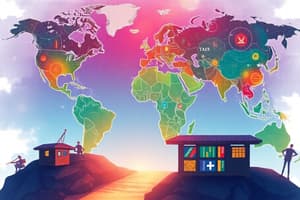Podcast
Questions and Answers
What is the primary focus of international business transactions?
What is the primary focus of international business transactions?
- To satisfy objectives of organizations only
- To focus on domestic markets only
- To satisfy objectives of individuals and organizations across national borders (correct)
- To promote exports only
Which international orientation views each host country as unique and approaches the markets differently?
Which international orientation views each host country as unique and approaches the markets differently?
- Regiocentric
- Geocentric
- Ethnocentric
- Polycentric (correct)
What does the SLEPT formula represent in the context of international business?
What does the SLEPT formula represent in the context of international business?
- Forms of international business
- Types of international business transactions
- International business orientations
- Environmental factors affecting international business (correct)
What is culture, according to the definition provided?
What is culture, according to the definition provided?
Which of the following is a characteristic of culture?
Which of the following is a characteristic of culture?
What is the first level of culture?
What is the first level of culture?
What is an example of an international business transaction?
What is an example of an international business transaction?
What is the primary difference between a polycentric and a regiocentric orientation?
What is the primary difference between a polycentric and a regiocentric orientation?
Which international business transaction involves the transfer of ownership and control of a company from one country to another?
Which international business transaction involves the transfer of ownership and control of a company from one country to another?
According to the EPRG framework, which international orientation approach sees similarities and differences in a world region and integrates its strategy within regions?
According to the EPRG framework, which international orientation approach sees similarities and differences in a world region and integrates its strategy within regions?
Which of the following environmental factors is most closely related to the values and customs of a society?
Which of the following environmental factors is most closely related to the values and customs of a society?
What is the primary characteristic of an ethnocentric international orientation?
What is the primary characteristic of an ethnocentric international orientation?
Which of the following is an example of a turnkey operation?
Which of the following is an example of a turnkey operation?
What is the primary difference between a geocentric and a regiocentric international orientation?
What is the primary difference between a geocentric and a regiocentric international orientation?
Which level of culture is shared by all members of a society?
Which level of culture is shared by all members of a society?
What is the primary function of licencing in international business?
What is the primary function of licencing in international business?
Flashcards are hidden until you start studying
Study Notes
International Business (IB)
- IB involves transactions across national borders to satisfy individual and organizational objectives
- Forms of IB: export/import trade, contract manufacturing, licensing, franchising, joint ventures, M&A, turnkey operations
International Orientations (EPRG Framework)
- Ethnocentric: home country experience is superior, similar to foreign countries, extension of local business strategy
- Polycentric: each host country is unique, adaptations of strategy in each foreign market
- Regiocentric: world consists of regions, similarities and differences in regions, integrated strategy within regions
- Geocentric: world is getting smaller, similarities and differences in home and host countries, global approach with local adaptation
Environment of IB (SLEPT Formula)
- Social and cultural factors
- Legal factors
- Economic factors
- Political factors
- Technological factors
Culture
- Collective programming of the mind that distinguishes one human group from another
- Includes systems of values, learned, shared, interrelated ways of understanding, deciding, and communicating
- Components of culture: shared motives, values, beliefs, identities, and interpretations of significant events
- Characteristics of culture: learned, shared, intergenerational, symbolic, structured, adaptive
Levels of Culture
- Universal level
- Collective level:
- Supra-culture: shared by nations with similar economic systems, ethnic roots, religion, etc.
- Macro-culture (national culture): shared by people of the same nationality, origin/country of residence
- Elements: values, attitudes, moral codes, religion, aesthetics, art, tastes, symbols, language, tradition, manners, customs, social interactions, education, technology, material culture
International Business (IB)
- IB involves transactions across national borders to satisfy individual and organizational objectives
- Forms of IB: export/import trade, contract manufacturing, licensing, franchising, joint ventures, M&A, turnkey operations
International Orientations (EPRG Framework)
- Ethnocentric: home country experience is superior, similar to foreign countries, extension of local business strategy
- Polycentric: each host country is unique, adaptations of strategy in each foreign market
- Regiocentric: world consists of regions, similarities and differences in regions, integrated strategy within regions
- Geocentric: world is getting smaller, similarities and differences in home and host countries, global approach with local adaptation
Environment of IB (SLEPT Formula)
- Social and cultural factors
- Legal factors
- Economic factors
- Political factors
- Technological factors
Culture
- Collective programming of the mind that distinguishes one human group from another
- Includes systems of values, learned, shared, interrelated ways of understanding, deciding, and communicating
- Components of culture: shared motives, values, beliefs, identities, and interpretations of significant events
- Characteristics of culture: learned, shared, intergenerational, symbolic, structured, adaptive
Levels of Culture
- Universal level
- Collective level:
- Supra-culture: shared by nations with similar economic systems, ethnic roots, religion, etc.
- Macro-culture (national culture): shared by people of the same nationality, origin/country of residence
- Elements: values, attitudes, moral codes, religion, aesthetics, art, tastes, symbols, language, tradition, manners, customs, social interactions, education, technology, material culture
Studying That Suits You
Use AI to generate personalized quizzes and flashcards to suit your learning preferences.




